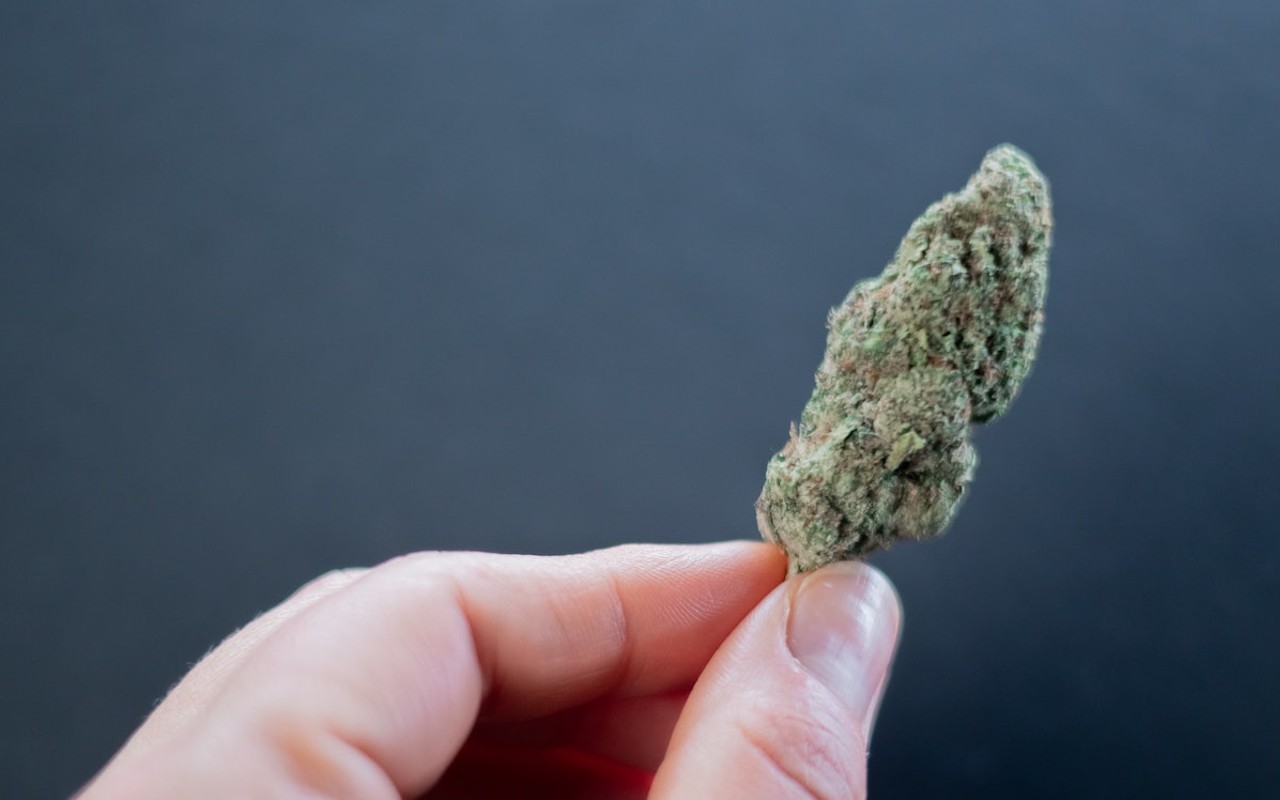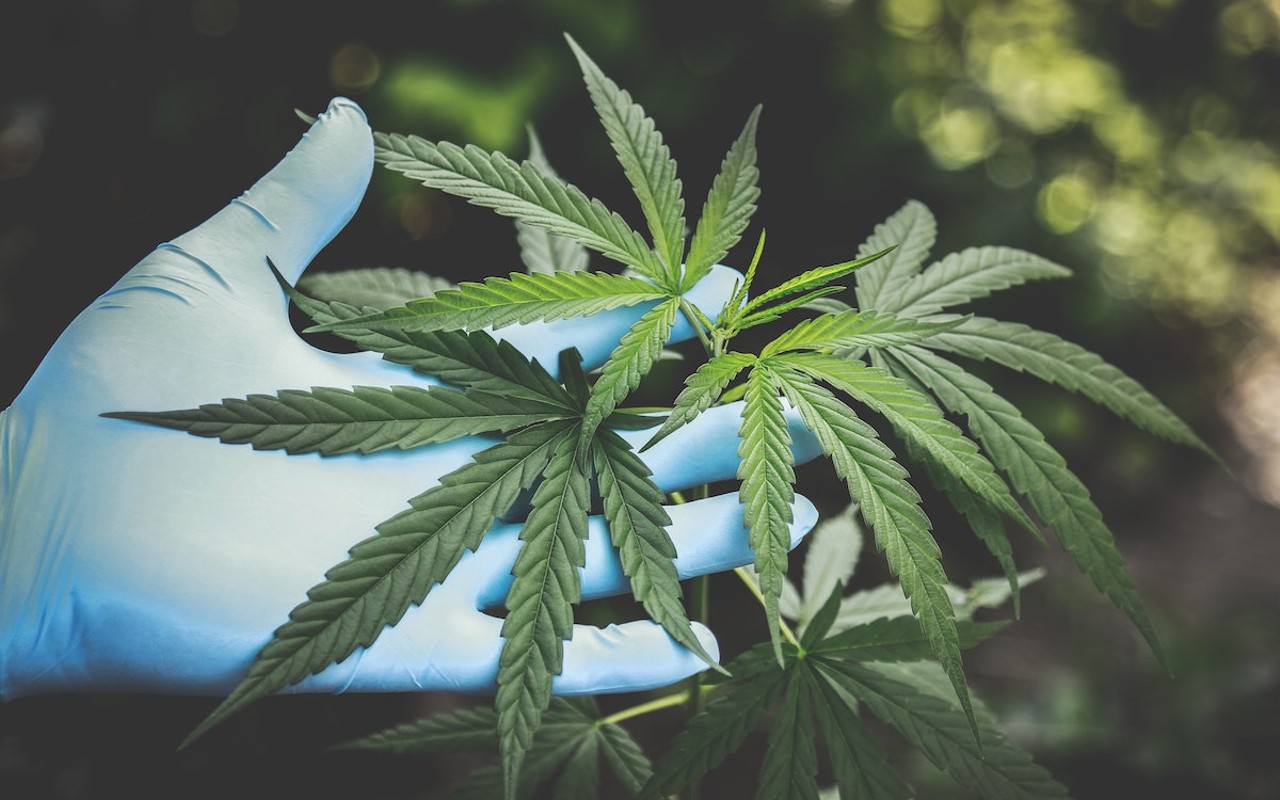This story is featured in CityBeat's April 17 print edition.
Mark S.’s son calls him the Walter White of the family.
“He's completely aware that it's not something for kids,” Mark tells CityBeat. “I've told him straight up, like, once you're 18, you know this is going to be something you can try if you want to? But it's also something you don't have to try, it's completely up to you.”
No, Mark is not talking about meth. He’s talking about growing marijuana, cannabis, weed, pot — whatever term your brain (and soul) gravitates towards when talking about the naturally occurring green plant that’s eased our pain and gotten us high for a dozen millennia. With the help of some fancy equipment and a lot of patience, Mark’s growing his first marijuana plant in his house in Mt. Lookout. While he keeps his plant tucked away from plain view, he’s not hiding anything — Ohioans voted to lift the prohibition of marijuana in November in the form of Issue 2, giving Mark the right to legally grow up to 12 marijuana plants in his family’s home.
“I've got a beautiful healthy plant in the grow tent in my basement that is flourishing and doing really well,” he says.
Mark’s first seed was planted once the new adult-use marijuana law went into effect in December, meaning his plant will be ready for harvest just in time for 4/20, but those without a green thumb will have to wait to legally join in on the fun. Lawmakers in the Ohio Statehouse have yet to finalize the new adult-use recreational marijuana law that voters overwhelmingly passed in November, meaning dispensaries won’t be selling recreational cannabis anytime soon.
While the powers that be figure out how and when to open the flowering floodgates on legal weed, cultivation season is underway for those navigating their first legal home-grow journey.
Growing a greener thumb
Funny enough, Mark isn’t really much of a weed smoker.
“I consume a product maybe once or twice a year,” he says. “It's interesting to really be more of a mad scientist.”
In the rare event he and his wife would purchase marijuana, the old-school route of coordinating with a dealer was their only option.
“My wife and I have been purchasing marijuana on the black market for many, many years,” Mark says. “We realized soon after the issue passed that it didn't mean we would be able to go to any place and simply buy it on the open market. And the only real clear legal path for us to procure it outside of the black market was to grow it in our house.”
Mark’s never really had great luck with keeping indoor plants alive, saying the typical house plant “goes south fast” in his house from underwatering. He knew he needed to approach his first cannabis plant differently.
“I knew if I had a special project like this I’d stick with it,” he says. “It's sort of like brewing beer, you've gotta have the right equipment to do it. It's not like it's really, really hard to grow a weed in the right kind of conditions — they say ‘grows like a weed’ for a reason.”
You won’t find the typical domestic botanist aesthetic in a home-grow setup like Mark’s — he’s spent about $300 on equipment that makes his one and only weed plant look like it’s training to work in outer space, encased in a grow tent with lights and a fan. There’s even a filtration system that helps to keep the skunky marijuana odor at bay.
“Unless you don't mind your whole house smelling like pot, you really do have to have some sort of a filtration system, which is just a blower with an activated carbon filter,” Mark says. “That's not to say it's a terrible odor. When I opened up the tent right now, it's kind of a pleasant odor. But I think when we get to the flowering stage, that's when it's gonna start to really stink the place up.”
Growing one plant will yield more than enough marijuana flower for Mark and his wife, but they’re legally allowed to grow up to six plants each with a cap on 12 plants per household, according to Issue 2 language approved by voters.
“Who's got a room for that?” he jokes.
For those who want to take on that challenge, the final say on how many marijuana plants they could legally grow is hazy. That’s because the legislature has been working to finalize the rules about the state’s new adult-use cannabis program, even though voters have already made it clear what they want in a weed-legal Ohio.

Writing the rule book
It all started when the Coalition to Regulate Marijuana Like Alcohol successfully brought Issue 2, a proposal to legalize adult-use marijuana sales, to the November 2023 ballot through a state-wide signature collection campaign. Issue 2 passed with 57% of voters in support of legalizing and regulating the cultivation, manufacturing, testing and sale of marijuana to Ohioans 21 and up.
The law passed by voters also legalized home grow for Ohioans 21 and up with a limit of six plants per person and 12 plants per residence. Under the initiative, adults are allowed to possess up to 2.5 ounces of marijuana and up to 15 grams of marijuana concentrates, which is a more densely potent cannabis product extracted from the marijuana plant.
Issue 2 imposed a 10% tax at the point of sale for dispensary transactions. Those tax dollars have been a major point of contention within the Ohio Statehouse after Issue 2’s passage. Under the law passed by voters, tax revenue from the recreational program would be allotted as follows:
- 36% to the host community cannabis fund
- 36% to the cannabis social equity and jobs fund
- 12.5% of the substance abuse and addiction fund would go into Ohio’s 988 Suicide & Crisis Lifeline fund to administer the 988 system
- 10% of the substance abuse and addiction fund would provide mental health and addiction services in county jails
- 3% to the operations of the Division of Marijuana Control and Department of Taxation
- 2.5% to the Department of Mental Health and Addiction Services to develop the state’s mental health workforce
House Bill 86
But once Issue 2 passed, some Ohio Senate Republicans proposed a radically different allocation of tax revenue in the form of edits to House Bill 86, which was originally written to revise the state’s liquor control laws. House Bill 86 would limit home grow from 12 plants per household to six, up the tax rate from 10% to 15%, lower maximum THC limits on cannabis products and change how the tax revenue is distributed:
- 28% to the county jail construction fund
- 19% to the Department of Public Safety law enforcement training fund, or 16% if the marijuana expungement fund has ceased to exist
- 14% to the Attorney General law enforcement training fund
- 11% to the substance abuse, treatment, and prevention fund, or 9% if the marijuana expungement fund has ceased to exist
- 9% to the 988 Suicide & Crisis Lifeline fund
- 5% to the marijuana receipts drug law enforcement fund
- 5% to the marijuana expungement fund
- 5% to the safe driver training fund
- 4% to the Ohio Investigative Unit Operations fund
- 3% to the Division of Marijuana Control Operations fund
- 2% to the marijuana poison control fund
Senate President Matt Huffman and Gov. Mike DeWine urged passage of HB 86, saying passing the bill quickly would limit the black market, but the Ohio House is unlikely to approve the bill, according to Ohio House Speaker Jason Stephens.
“Getting a consensus on what that action will be in the House is probably not going to happen,” Stephens, a Lawrence County Republican, told reporters at the Ohio Statehouse on April 2. “I think there’s been a lot of discussion and talk within the House, within the Republican (House) caucus, frankly. And getting those (talks) to where we have a consensus of saying, ‘this is what needs to be different than what the people passed’ — there’s just not that consensus right now.”
Lawmakers initially predicted that recreational sales wouldn’t start until late summer or fall, but state rep. Jamie Callender (R-Concord) told WEWS reporter Morgan Trau that legal sales could be coming as early as mid-June.
“We could have retailers, recreational licensed retailers, in Ohio by mid-June,” Callender told Trau. “We should begin to see legal recreational sales of marijuana in Ohio certainly before July 4th weekend.”
The Department of Cannabis Control (DCC) wasn’t even supposed to start processing retailer applications until June, per Issue 2’s language, but Callender tells Trau that DCC has been working quickly and that the Joint Committee On Agency Rule Review (JCARR) plans to accept proposed regulations from the DCC, further speeding up the process.
“There’s a lot of other issues around the marijuana market and industry that may need to be looked at, but this will give the governor and the Senate the immediacy that they were looking for,” Callender told Trau.
Common Sense Initiative
The Ohio Division of Cannabis Control has put forth its own proposed changes to the program, known as the “Common Sense Initiative,” but the voters who passed Issue 2 may like the sound of these additions.
On April 3, the Ohio Division of Cannabis Control submitted a 45-page rules package that would make shopping for your weed a lot easier, allowing for dispensary drive-through windows, self-serve kiosks and curbside pickup; customers just need to show their ID. The area surrounding the drive-through or curbside pickup area must also be video-monitored.
The Ohio Division of Cannabis Control’s rules would also allow Ohioans to make a late-night weed run by expanding the hours of operation for dispensaries. Currently, dispensaries can only sell between 7 a.m. and 9 p.m. within the confines of their four walls, but the proposed rules would allow businesses to remain open until 11 p.m.
The Common Sense Initiative also outlines specifics on waste disposal, suggesting the state require all adult-use license holders to destroy all “excess, unwanted, outdated, deteriorated, adulterated, or misbranded cannabis under video surveillance and in a manner as to render the cannabis unusable and non-retrievable.”
Dispensaries would have to grind up unwanted cannabis products with other types of waste — specifically 51% non-cannabis waste — which could include paper, cardboard, compostable oils and grease, food, garden waste and/or compost activators. Thorough records of the waste destruction, including video proof, must be maintained at all times.
The agency’s proposed rules would also tighten distance requirements between dispensaries and “prohibited facilities” like schools, churches, libraries, parks, etc. The rule for medical dispensaries now is to keep their property lines at least 500 feet away from a prohibited facility’s property lines, but the new rules would change where that 500 feet starts. Instead, it would require the distance to be measured by the “shortest distance” between the dispensary’s physical structure and the property line of the prohibited facility.
The rules package will be reviewed by Lt. Gov. Jon Husted’s office and lawmakers.
Dispensaries wait for the green light
While those in power determine the specifics behind Ohio’s new adult-use law, dispensaries tell CityBeat they are fully prepared to make the switch from medical to a med-rec program.
“We've begun the process of planning, not knowing exactly what the date is, but making sure that everything from the flow of our stores to having the right kind of staff to making sure we will have inventory in stock to be able to accommodate all those consumers,” said Jason Erkes, chief communications officer for Cresco Labs.

Cresco Labs says it is one of the nation's largest multi-state marijuana operations, also known as MSOs. Though they are multi-state, federal law requires Cresco Labs to grow, cultivate and sell their cannabis products within state lines. They sell their cannabis products grown in Ohio to various dispensaries across the state, but consumers are more likely to know the Cresco Labs company through its retail arm of the brand, known as the Sunnyside dispensaries.
“We have 71 [Sunnyside] stores right now across the country. We have five in Ohio, and with the new adult-use legislation, we’ll get three more,” Erkes says.
The weed grown in Cresco’s Yellow Springs cultivation site goes straight to Sunnyside dispensary in Oakley at 5149 Kennedy Ave. Cresco’s been at the forefront of medical cannabis cultivation and sales in the state so far.
“Our Sunnyside in Wintersville was the first sale, the first medical cannabis sale in the state of Ohio,” Erkes says. “Our facility in Yellow Springs was the first facility to actually break ground and get up and running.”

Despite Cresco’s plan to expand by riding Ohio’s recreational market wave, Erkes tells CityBeat the emphasis will always be on medical patients.
“If there is a supply shortage in the state, medical consumers will obviously get first priority on being able to get access to their medicine,” he said. “I love the way this product impacts and changes people's lives and it's significant.”
The question of a shortage seems inevitable. After all, recreational customers and medical customers will be going to the same dispensaries across the state to access their weed. But it won’t just be Ohioans buying their cannabis products, especially in the Tri-State.
“You're gonna see a fair amount of folks from Kentucky and Indiana coming over to buy cannabis,” said Jason Vedadi, CEO of Story Cannabis, a Maryland-based MSO. “Downtown Cincinnati will be kind of a target — Kentucky folks and Indiana folks probably don't have any real line of sight to recreational use anytime soon.”
Story Cannabis says it’s on the medium side of typical multi-state operations, priding itself on providing a small-town atmosphere to its 17 total locations. In Ohio, Story Cannabis has one location in Coshocton, a small town an hour and a half northeast of Columbus, and two side-by-side locations in Cincinnati’s Oakley neighborhood near Rookwood Commons. Story I and II, while side-by-side, are licensed by separate LLCs.
Like Sunnyside, Story says it thinks of the medical customer first.
“We continue to offer certain things for medical patients that recreational patients don't get,” Vedadi says. “But I do anticipate that there'll be some convenience factors that don't exist, just in the sheer nature that the market is gonna go from $600 million to $2 billion in sales over some period of time. But you definitely try to stay sensitive, especially those people with more serious ailments to make sure that they're taken care of.”
Unlike Sunnyside, Story does not grow its own weed in the state — it depends on cultivators and wholesalers who have a leg up on pricing. He says prices may go up in the months after adult use goes live, but he’s telling medical customers that pop won’t last long.
“When demand goes up, I think people are more concerned that the price is gonna skyrocket,” Vedadi says. “[Wholesalers] control pricing, we don't control pricing, but the market normalizes. [...] It really is a commodity when you think about it. Like, it's no different than wheat or anything else. So usually you see a spike in pricing at first, and then over the course of time, it stabilizes.”
Erkes from Sunnyside said even with a slight spike in pricing from demand, medical customers will pay less for their products in the form of a tax break. They’ll also get easier, faster access to products while the droves of out-of-state recreational customers wait in their own lines.
“There will be a significant tax break still to have a medical card, and you still will get that priority over everyone else,” Erkes says. “We certainly prioritize medical patients, as is the foundation of who we are, and many of our stores will have a medical line and an adult use line and the medical patients essentially have a VIP pass to get through.”
Medical marijuana’s evolving presence
Separate lines, dwindling supply — these are the fears that some medical cannabis patients have mentioned to Dr. James Weeks, who runs One Heart Medical, a doctor’s office that exclusively assesses and recommends patients for the state’s medical cannabis program. Of the thousands of patients he’s seen since opening his Delta Avenue office in Cincinnati’s Columbia Tusculum neighborhood, he’s had hundreds of questions about how Issue 2 will impact dispensary lines for medical marijuana customers.

“Whenever it became clear that [57%] of Ohioans wanted cannabis legalization, people started firing up questions,” Weeks tells CityBeat. “That's what everyone's concerned about. It’s a real concern that I’ve heard like a broken record since the November election.”
While Ohioans won’t need a doctor to legally access weed anymore, that doesn’t mean some won’t still go the medical route to get their cannabis products — even in a recreational-friendly state. Weeks said he has every reason to believe he’ll start to see more medical marijuana patients after Issue 2 passes, not less.
“It’s a shame that people say this, but they'll say, ‘Hey, Dr. Weeks, I see adult recreational is legalized. What are you going to do? Like, you're out of business, right?’ It's like, yeah, well, there's still gonna be a medical program. And not only that, but I suspect, and it's just a hypothesis, our volume will go up,” Weeks says.
Beyond the obvious perks of a 10% tax break and potentially faster lines, Weeks says it’s the shifting demographics of medical patients and weed smokers in general that appears to be spelling out a longer future for the medical program.
“We've reached a point where demographics have shifted to where the average age was late 40s, to now average age is late 50s. We're shifting into this older population,” Weeks says. “It’s a valuable population. Most folks report benefits with minimal side effects.”
Weeks recalls a patient who he says reflects a common trend among Baby Boomers — a woman who never smoked weed once in her life but found comfort in the state approving adult use before she pursued the medical program in her 70s.
“She declared right off the bat, ‘Are there a lot of different ways to take this?’ And I said, ‘Oh, yeah.’ And she goes, ‘You don't just have to smoke it?’ And I said, ‘Oh, no.’ And she's like, ‘OK, good, because I didn't really want to smoke it.’ I asked her, you know, somebody who lived through the ‘60s and ‘70s, you never smoked it? She's like, ‘No,’” Weeks says. “We see that a lot. Because there is this group of a lot of people that have never tried this before, they're very reluctant and having someone that has an internal med background, that their doctor referred them in our direction, they're going to buy into it more.”
Weeks went into recommending medical cannabis full-time after more than a decade spent working in hospitals during the opioid epidemic. Now he insists on seeing patients in person to help them not only weigh their options for pain management but demystify and destigmatize cannabis altogether.
“Probably half of what I do is provide reassurance. I just reassure that it's safe, it's not going to make you pass out, it’s not going to cause cancer, or whatever the question is. You don't have to be high, you don't have to feel loopy, it’s not a gateway drug, you're not going to crave it and become tolerant and need triple in three months,” Weeks says. “The stigma is reducing because people are now recognizing, hey, it's legal, Ohioans voted for this, maybe it's my turn to try it.”









